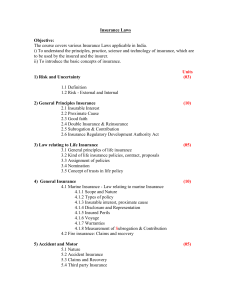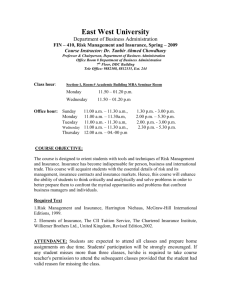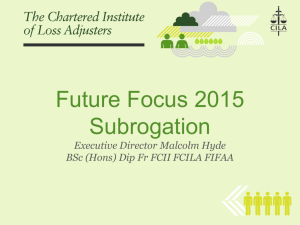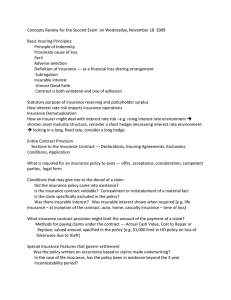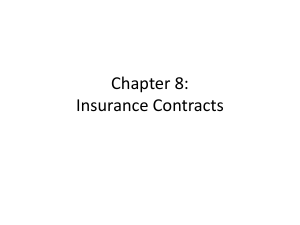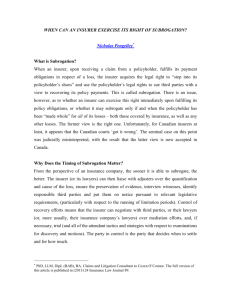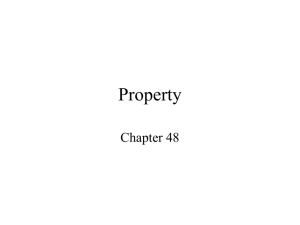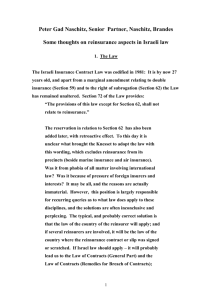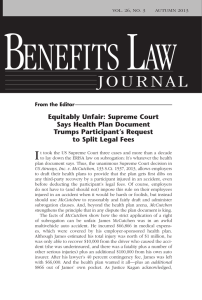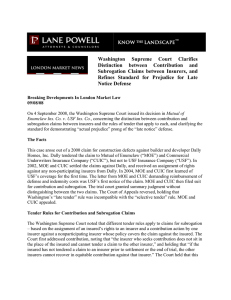1 It is an unfortunate fact that construction projects are fertile... injury and property damage liability ...
advertisement
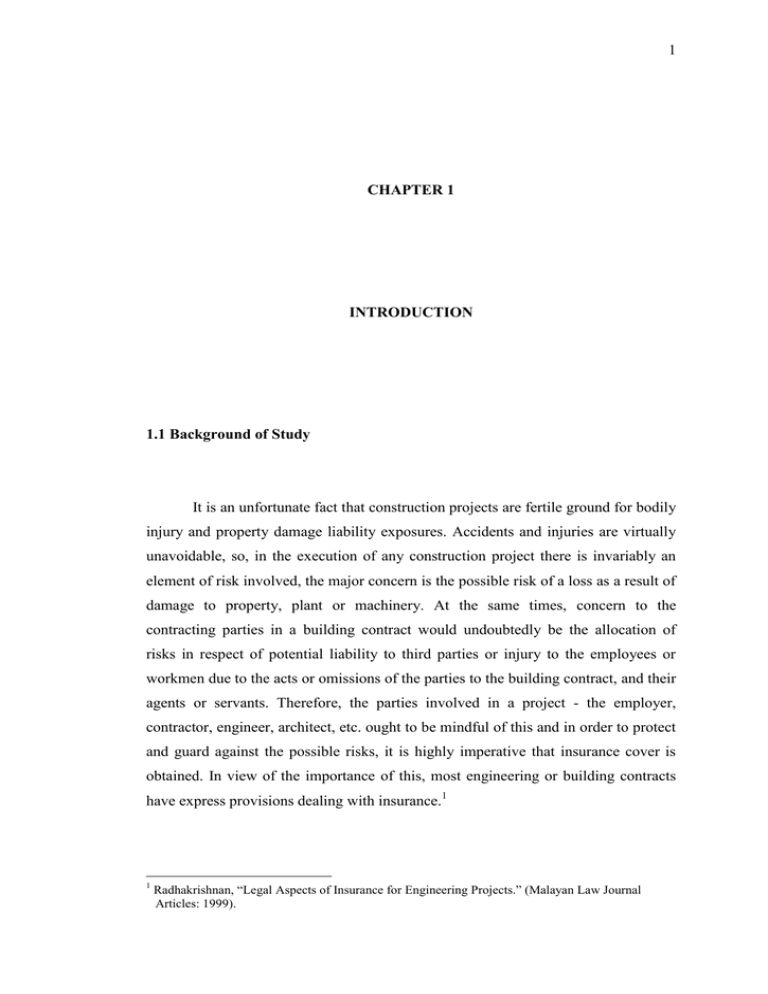
1 CHAPTER 1 INTRODUCTION 1.1 Background of Study It is an unfortunate fact that construction projects are fertile ground for bodily injury and property damage liability exposures. Accidents and injuries are virtually unavoidable, so, in the execution of any construction project there is invariably an element of risk involved, the major concern is the possible risk of a loss as a result of damage to property, plant or machinery. At the same times, concern to the contracting parties in a building contract would undoubtedly be the allocation of risks in respect of potential liability to third parties or injury to the employees or workmen due to the acts or omissions of the parties to the building contract, and their agents or servants. Therefore, the parties involved in a project - the employer, contractor, engineer, architect, etc. ought to be mindful of this and in order to protect and guard against the possible risks, it is highly imperative that insurance cover is obtained. In view of the importance of this, most engineering or building contracts have express provisions dealing with insurance.1 1 Radhakrishnan, “Legal Aspects of Insurance for Engineering Projects.” (Malayan Law Journal Articles: 1999). 2 Those insurance provisions always required that the employer or contractor to to take out appropriate insurance policies to cover the extent of the risk in respect of which they are obliged to indemnify the employer under the contract. 2 The insurance policy is a contract of indemnity whereby one person normally called the insurer, in return for a consideration or premium, to pay to another person, normally called the insured, a sum of money or its equivalent upon the happening of certain specified occurrences.3 Where insurers have made a payment to their insured and indemnified him against his loss they stand in his shoes and are entitled to take over from him rights and remedies which he may have against some other person. This principle gives rise to further insurance factors, namely subrogation. However, to becoming engaged in the complexities of lawsuits and insurance claims, while managing the risk and associated expenses 4 , the parties will often contract to joint names or waive all right of subrogation against the other party as part of the contract governing their relationship. The named insured intentionally relinquished any right to recover damages from another party who may be responsible. While exculpatory, these types of clauses are generally upheld 5. 2 Chow Kok Fong, “The Law Related to Building Contracts Cases & Materials.” (Singapore: Quins, 1983), p.262-263. 3 Peter Madge, “A Guide to the Indemnity and Insurance: Aspect of Building Contracts.” (London: RIBA Publications Limited, 1985), p.13. 4 Kenneth A. Slavens, “What is Subrogation… and Why is My Contract Waiving it?”(IRMI.com, 2002), <http://www.irmi.com/expert/articles/2000/slavens12.aspx> 5 Fred D. Wilshusen, et. al., “Construction Checklist: A Guide to Frequently Encountered Construction issues.” 3 1.2 Problem Statements Clauses of construction contract relating to insurance and indemnities are often misunderstood by the parties to those contracts because the relationships of insurers, insureds and co-insureds can give rise to significant difficulties in managing risks associated with construction projects. The reason is that construction projects typically involve various independent parties bound together by complex contractual relationships. Pursuant to these contracts, it is common for certain parties to indemnify others in respect of particular risks. Furthermore, losses and liabilities are often caused by more than one party and covered by more than one insurance policy. 6 These are often not given a lot of thought and the risks of failing to understand these clauses can be significant.7 In the case of Petrofina (UK) Ltd and others v. Magnaload Ltd and others8, the plaintiffs, Petrofina (UK) Ltd, Total Oil Great Britain Ltd, Lindsey Oil Refinery Ltd and a consortium of companies trading under the name of Omnium Leasing Ltd claimed against the defendants, Magnaload Ltd and Mammoet Stoof BV on damages for negligence. The claim arises out of an accident which occurred in the course of carrying out a major extension to an oil refinery. Two men lost their lives in the accident and there was extensive damage to property. The defendants contended that they were sub-contractors employed to carry out the contract works and that any claim against them was covered by a contractor's all risks policy taken out by the head contractors, Foster Wheeler Ltd to cover all risks arising out of any acts or negligence of the contractors and the sub-contractors in respect of the construction, erection and extension to the Lindsey Oil Refinery. The defendants also issued third party notices on Greenham (Plant Hire) Ltd, who was sub-contractors of the head contractors and on the New Hampshire Insurance Co., the insurers of the policy taken out by the head contractors. The insurers having settled the plaintiffs' claim 6 Andrew Byrne, “Construction Projects and the Apportionment of Liability Insurance & Reinsurance Forum.” (Allens Arthur Robinson: 2009), p.2. 7 “Do you have it Covered? Construction Contracts: indemnity of third party Co-insureds in Contract Works and Public Liability Insurance Policies.” (HWL Ebsworth Lawyers, 2008), <http://hwlebsworth.ensoconsultancy.com.au/building_construction_august08/index.html> 8 [1984] 1 QB 127. 4 under the policy, sought to exercise their right of subrogation against the defendants. The defendants claimed that since they were sub-contractors and therefore fully insured under the policy, the insurers had no right of subrogation. Issue of whether the insurer may seek the right of subrogation against defendants arise. The judge held that the insurers‟ rights of subrogation were defeated by reason of the fact that the defendants were fully insured. Again in the case of Louisiana Fire Ins. Co. v. Royal Indemnity Co. et. al.,9 the defendant was a plumbing contractor who was working only on part of the insured building. After the structure was damaged by fire, the builders' risk insurer brought suit against the plumbing contractor for the loss. The Louisiana Court of Appeals held that the insurer could not exercise subrogation rights. First, the court concluded that the "evident intent of the parties, and the customs and practices of the building trade" evidenced the intent to provide protection under the owners' builders' risk policy for everyone involved in the project. Second, the court reasoned that the policy was ambiguous, so it had to be construed against the insurer. While this case is sometimes cited for the proposition that subrogation is prohibited as a matter of law, the language quoted would seem to suggest that subrogation against a contractor is permissible if the parties to the insurance contract so intend, since the court relied on two rules of construction-industry custom and the doctrine of contra proferentem and specifically referenced the intent of the parties. None of this would have been relevant unless the parties had freedom of contract. United States Fire Insurance Co. v. Donald Beach, dba Beach Steel Erectors, 10 et al., another Louisiana Court of Appeals case, similarly suggests that the parties to an insurance contract might agree that the underwriters could subrogate against additional assureds. While the court reached the same result as in Louisiana Fire and concluded that the insurer could not exercise subrogation rights, the court expressly 9 (1949), 38 So. 2d 807. (1973) 275 So.2d 473. 10 5 stated that this result was based "not upon any theory of estoppel," but was instead simply a matter of contract interpretation. Other courts, however, have taken a more doctrinaire approach, ruling that it is impermissible as a matter of law to allow subrogation against a party insured under the policy. In Baugh-Belarde Construction Co. v. College Utilities Corp., 11 the Alaska Supreme Court cited several policy reasons for precluding a builders' risk insurer from exercising subrogation rights. In a case decided by the Court of Appeals in February, 2008, Wisconsin State Local Government Property Insurance Fund v. Thomas A. Mason Company,12 the Court of Appeals held that the state agency created to provide property insurance for local governments had waived its right to subrogation recovery from a subcontractor. After several cases had been discussed, there are few questions which arise from the above discussion, whether a builders‟ risk insurer can exercise subrogation rights against sub-contractors and material suppliers whose negligence or faulty products have caused damage? What are the points that must be addressed by counsel for an insurer seeking to exercise subrogation right? Is there a waiver of subrogation in favour of the target that precludes such a suit? How subrogation claims are waived? Thus, in order to understand the issue of insurer was preventing from exercising subrogation rights in the construction industry, this study therefore intends to understand the insurers‟ right of subrogation claim under the insurance provision of the standard form of construction contract. 11 12 (1977) 561 P.2d 1211. (Ct. App. Feb. 20, 2008). 6 1.3 Research Objective In order to understand the insurers‟ right of subrogation claim in construction contract, the following is the objective of the study: (a) To identify circumstances that do not allow insurers to exercise their right of subrogation. 1.4 Scope and Limitations of Research The following are the scopes for this study: - This research is done by ways of literature review and study on the legal cases reported in LexisNexis in relation to construction insurances cases. The study focused on the insurers‟ subrogation right under a provision in the standard form of contract. Besides that, this research had been conducted relying on the information from articles, journals and books due to a lack of court cases related to the research objective. 7 1.5 Significance of Study Since construction insurance clauses were often misunderstood by the parties to those contracts, those who are not insurance experts always deal with those clauses and policies. The research is important to clarify the principle of the right of subrogation claims in the construction contract to these peoples. It will improve the understanding of the right of subrogation claims, to the benefit of contractors, principals and insurers. 1.6 Research Methodology The research objectives had been achieved as a systematic research process have been drawn up and adhered to. The research process consisted of four major stages, namely, identified the research issue, data collection, data analysis and writing. Each stage is shown in detail below. (Refer to Figure 1). 1.6.1 Identified The Research Issue The initial stage is to identify the area of study by choosing of the appropriate title, problem statement, and research scope and research objectives. This stage began with the choosing of field of research followed. Firstly, the overview of the concept of this topic was done through the initial literature review. On the other hand, the ideas and suggestion regarding to the research topic were also collected through discussions with supervisors, lecturers, as well as friends. Afterward, the objective and scope of research were determined and a research proposal had been 8 prepared in order to identify the types and sources of materials needed for this research. 1.6.2 Data Collection This stage involves the collection of relevant data and information. Data had been collected mainly through documentary analysis. All collected data and information had been recorded systematically. Data had been collected mainly from Malayan Law Journal, Singapore Law Report, Building Law Report, Construction Law Report and other law journals. Data had been collected by browsing through the LexisNexis legal database. All the cases relating to the research topic had been sort out from the database. Important and relevant cases had been collected and used for the analysis at the later stage. In addition, secondary data was also collected from books, article reports, seminar papers, newspapers and articles from the internet. All the relevant books had been obtained from the Universiti Teknologi Malaysia library and other public libraries. Moreover, seminar papers, article reports and newspapers were reinforced the theories found in books. All these sources are important for the literature review. 1.6.3 Data Analysis and Interpretation During this stage, the case laws collected and all the relevant information had been specifically arranged and analyzed and also interpreted based on the literature review is converted into information that is useful for the research. The researcher 9 was carefully reviewed the relevant case laws collected and also pay special attention to the facts of the case, issues and judgments presented by each case law. 1.6.4 Writing The last stage of the process involved writing up and checking of the completed report. A conclusion had been made and at the same time recommendations related to the problem may be made in this stage. The author has also reviewed the whole process of the research to identify whether the research objective has been achieved. 10 Research Methodology Establish Area of Study Books Arbitration Act Articles and journal Seminar papers Internet website Formulate Objective and Defined Scope Research Design Data Collection Documentary Analysis Court cases form MLJ, Building Law Report and other law journals (Lexis Nexis) Academic books Seminar papers Journals and Articles Data Arrangement Data Analysis and Interpretation Writing and Checking Figure 1.1: Research Methodology Flowchart 11 1.7 Chapter Organization This research dissertation will be divided into 5 chapters Chapter 1 This chapter sets out the background of the study and identified the research issues. It also consists of the objective of the research that stated the aims of the study, scope and limitation of the study, research methodology to be carried out to reach the objective of the dissertation and the organization of the chapter. Chapter 2 This chapter discusses the fundamental principle of insurance; types of insurance required under the standard form of construction contract and insurance clause under the contract. Chapter 3 This chapter discuss in detail the principle of subrogation under the insurance law. Chapter 4 This chapter review and analysis the court cases had been selected in order to discuss the circumstances that do not allowed the insurer to exercise their right of subrogations. Chapter 5 This is the final part of the whole report whereby it conclude the findings for the whole research, and summarises on the research findings, conclusion and recommendations and suggestions for further research.
